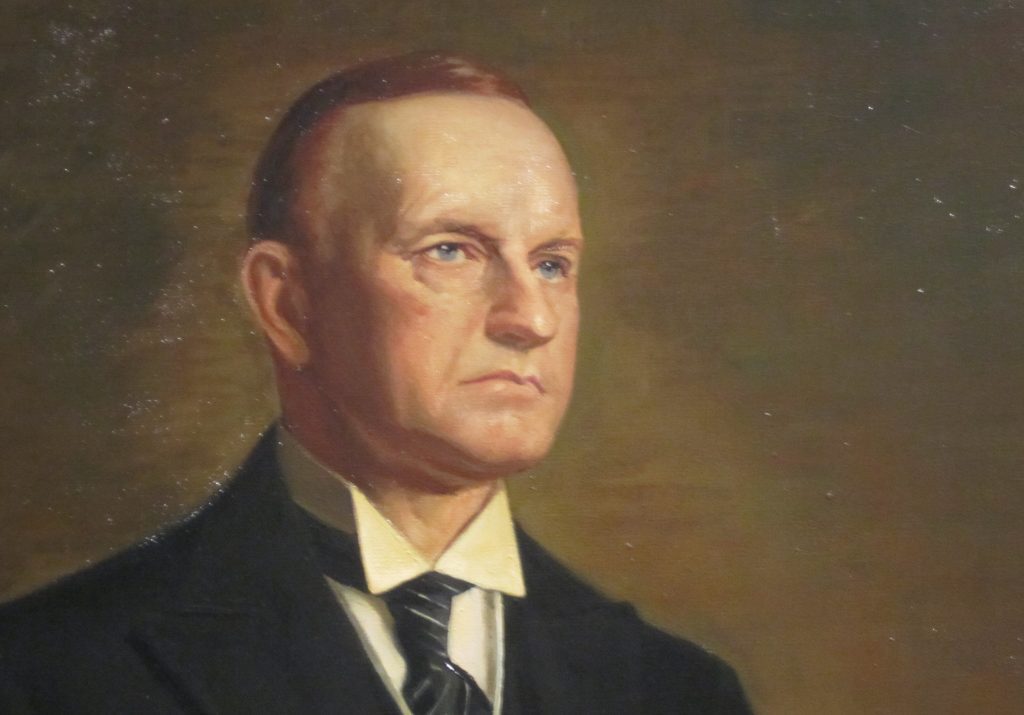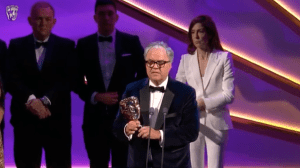On Thursday evening, October 28, 1920, vice presidential candidate Silent Cal Coolidge invaded Manhattan.
Commencing from Wall Street, his plan was to process steadily uptown, being joined by as many supporters as he might, to finally reach Carnegie Hall, there to address whatever Republican faithful he might attract within the city limits.
The New York Times, for some reason, lacked faith that much might come from his plan.
But as Coolidge advanced ever northward, a full seventy-five thousand enthusiastic marchers joined with him, representing any number of the city’s trades and professions. They advanced through Greenwich Village’s Washington Square and up Fifth Avenue. A segment formed a giant electric American flag. And when the candidate reached Carnegie Hall, he found it full to overflowing. So much so that a young man named Whitaker Chambers (not yet a Communist nor a spy nor a hero) perched himself upon a fire escape to be inspired by his words.
Ah, that was some night.
It has been tough sledding for Cal’s reputations for quite some decades now. The historians have scoffed. The economists have mocked. His ungrateful conservative heirs have largely ignored his impressive record of cutting spending and taxes and jump starting the economy.
But, suddenly that has changed—and wildly so. Commentators from Grover Norquist (“We’re looking for another Coolidge”) to Jonah Goldberg (“Coolidge was one of the greatest presidents of the 20th century and is certainly the most underrated”) to George Will (“Calvin Coolidge, the last president with whom I fully agreed . . .”) to Mark Steyn (“If you’re like me and your idea of a conservative president is Calvin Coolidge . . .”) to Glenn Beck (Coolidge “might be my favorite President so far. I like the guy”) have sung his praises.
With such a wind at their back, modern Coolidgites have taken heart and invaded Manhattan’s enemy territory yet again: occupying neither Wall Street nor Carnegie Hall but Midtown’s swank Four Seasons Restaurant, jamming it to honor Coolidge as well as the organization dedicated to his memory, the Calvin Coolidge Memorial Foundation.
The Foundation has been around for a while, fifty-some years to be exact, but three months ago it had the profound good sense to designate as its president Amity Shlaes, author of the recent best-selling Coolidge biography. In an era of fiscal profligacy and resultant stagflation, Ms. Shlaes’ Coolidge has initiated a discussion not only of what was done, but how it was done, and what will have to be done again. When The New Yorker devotes 4,000 words to Calvin Coolidge (as it did in reviewing Shlaes’ magnum opus), you know something’s up.
Her book has been a game-changer, stirring up debate on Coolidge and finally providing embattled conservatives with another hero besides the estimable Ronald Reagan—in fact, a more successful one, at least, on budgetary matters. Where Reagan ran a deficit, Coolidge cut taxes and spending, accumulated surpluses and sharply slashed the national debt. And where Reagan cashiered striking air traffic controllers, Coolidge dealt firmly with striking Boston police. “There is no right to strike against the public safety,” said Silent Cal, “by anybody, anywhere, any time.”
The numbers spoke for themselves—and still do. His accomplishments included:
- Reducing the national debt from $22.3 billion in 1923 to $16.9 billion in 1929.
- Reducing federal expenditures of $5.1 billion in 1921 to $3.3 billion in 1929.
- Cutting taxes four out of his six years as president.
- Reducing the highest effective tax rate from 50 percent (1922) to 25 percent but increasing revenue from that tax bracket from $77 million to $230 million.
- Slashing the tax burden on incomes under $10,000 from $130 million in 1923 to under $20 million in 1929; by 1927, 98 percent of the population paid no income tax.
“It is only a tiny exaggeration,” noted historian Thomas B. Silver, ‘‘to say that Coolidge and [Treasury Secretary Andrew] Mellon completely removed the burden of federal income taxation from the backs of poor and working people between the time Coolidge entered the presidency and the time he left.”
And such numbers worked wonders beyond the balance sheet, helping to trigger a widely-based economic boom:
- Unemployment averaged 3.3 percent from 1922 to 1929.
- The Gross National Product increased annually by 7 percent from 1924 to 1929.
- Per capita income grew 30 percent from 1922 to 1928.
- Real earnings for employed wage earners increased 22 percent from 1922 to 1928.
- Industrial production increased 70 percent from 1922 to 1928.
- The average workweek decreased 4 percent from 1922 to 1928.
- Automobile ownership expanded three fold in the decade.
But back to the present—and to the Pool Room (which really has nothing to do, I must say, with billiards at all) of the Four Seasons. What transpired provided powerful evidence that the study of Coolidge was no longer to be restricted to the nether regions of academia (or central Vermont). The joint was packed. If the Four Seasons had a fire escape, people would have been upon it. And quality certainly augmented quantity. Seen mingling among the crowd were Steve Forbes, CNBC’s Larry Kudlow, star Democratic pollster Doug Schoen, syndicated columnist Cal Thomas, Reagan Budget Director David Stockman, former Vermont Governor Jim Douglas, Wall Street Journal columnist Mary O’Grady, Manhattan Institute President Larry Mone, Hudson Institute Fellow (and former American Enterprise Institute president) Christopher DeMuth, authors George H. Nash (the nation’s premier Herbert Hoover scholar), Charles C. Johnson (another Coolidge biographer) and Dr. James Otteson (a Templeton Enterprise Prize winner), John Batchelor Show producer Lee Mason, the Bush Institute’s Machir Stull—and The Federalist’s own Ben Domenech.
Awards were properly presented, and counted among the ranks of those judging the competition for the CCMF’s newly-minted “Coolidge Award” for journalists (won by the Wall Street Journal’s brilliant Holman Jenkins) were historian Richard Norton Smith, former Indiana Governor Mitch Daniels, and Bloomberg TV’s Trish Regan.
The biggest name (and at 6’7”, the biggest person period) gracing the evening’s program was a surprising one: legendary former Federal Reserve Chairman Paul Volcker. Volcker, however, already stood on record in praise of Coolidge, telling Shlaes very recently, “What we understood was that Coolidge was kind of a do-nothing president. He took over for Harding, he was an honest guy, he was kind of open and frugal, but that was it. But in fact there’s so much to learn from Coolidge. Any president is going to face a lot of problems and Coolidge faced up to them. He produced, after Harding, honest government. He contributed to some degree of trust in government.” At the Four Seasons, the still feisty (at 86) Volcker predicted, “The day will come . . . they will have to permit the normal market forces to operate in such a way that interest rates may resume more normal levels.”
The Thirtieth President’s message, Coolidge Prize winner Holman Jenkins later commented, allows us to “better understand the forces bearing on the president and Congress almost a century later. I am honored to accept this Prize . . . maybe it will help us to remember what Coolidge stood for at a time when we need him most.”
Award-winning historian David Pietrusza has produced three books on Calvin Coolidge: Silent Cal’s Almanack: The Homespun Wit and Wisdom of Vermont’s Calvin Coolidge, Calvin Coolidge: A Documentary Biography, and Calvin Coolidge on The Founders: Reflections on the American Revolution & the Founding Fathers.



